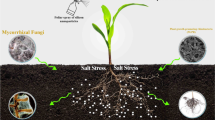Abstract
Seed preconditioning, a short gun approach to modulate the effects of abiotic stresses on crop plants, has recently gained considerable attention of the researchers to induce salinity tolerance in agronomically important crops. The present study was conducted to explore the comparative efficacy of presowing seed priming with silicon (Si) and Si fertigation to modulate the wheat growth and ion dynamics. Seeds of wheat variety, PUNJAB-11, were sown in Petri plates having nutrient solutions with (120 mM) and without NaCl. Six levels of Si (0, 10, 20, 30, 40, or 50 mM), applied as sodium silicate (Na2SiO3), were tested either as a seed priming agent or as a supplement in the nutrient solution. Priming of seeds with Si mitigated the adverse effects of salinity stress on germination percentage, root as well as shoot length, dry and fresh weight. Application of Si either as preconditioning of seeds or addition in the growth medium resulted in reduced accumulation of sodium (Na+) in wheat seedlings under saline environment. Seedling’s potassium (K+) contents either remained unaffected or decreased whereas calcium (Ca2+) contents decreased at all Si concentrations except at 30 mM when Si primed seeds were grown under salt stress. Addition of Si, under salt stress, in cultivation medium exerted a positive effect on seedling’s K+ and Ca2+ contents. Silicon contribution to decontamination strategies was evaluated.

Similar content being viewed by others
References
Ahmad R, Zaheer SH, Ismail S (1992) Role of Si in salt tolerance of wheat (Triticum aestivum L.). Plant Sci 85(3):43–50
Al-aghabary K, Zhu Z, Qinhua S (2004) Influence of silicon supply on chlorophyll content, chlorophyll fluorescence and antioxidative enzyme activities in tomato plants under salt stress. J Plant Nutr 27(9):2101–2115
Ashraf M, Harris PJC (2004) Potential biochemical indicators of salinity tolerance in plants. Plant Sci 166(5):3–6
Cramer GR, Nowak RS (1992) Supplemental manganese improves the relative growth, net assimilation and photosynthetic rates of salt-stressed barley. Physiol Plant 84(4):600–605
Eliasson L (1978) Effect of nutrients and light on growth and root formation in Pisum sativum cuttings. Plant Physiol 43:13–18
FAO (2008) FAO land and plant nutrition management service. http://www.plantstress.com/articles/salinity_i/salinity_i.htm
Fauteux F, Rémus-Borel W, Menzies JG, Bélanger RR (2005) Silicon and plant disease resistance against pathogenic fungi. FEMS Microbiol Lett 249:1–6
Flowers TJ (2004) Improving crop salt tolerance. J Exp Bot 55(2):307–319
Gong HJ, Randall DP, Flowers TJ (2006) Silicon deposition in the root reduces sodium uptake in rice seedlings by reducing bypass flow. Plant Cell Environ 11(1):1–9
Greger M (1999) Metal availability and bioconcentration in plants. In: Prasad MNV, Hagemeyer J (eds) Heavy metal stress in plants. From molecules to ecosystems. Springer Verlag, Berlin, pp 1–27
Javed MT, Greger M (2011) Cadmium triggers Elodea canadensis to change the surrounding water pH and thereby Cd uptake. Int J Phytoreme 13:95–106
Liang Y, Chen Q, Liu Q, Zhang W, Ding R (2003) Exogenous silicon (Si) increases antioxidant enzyme activity and reduces lipid peroxidation in roots of salt stressed barley (Hordeum vulgar L.). J Plant Physiol 160(10):1157–1164
Liang YC, Zhang WQ, Chen J, Ding R (2006) Effect of silicon on H+-ATPase and H+- PPase activity, fatty acid composition and fluidity of tonoplast vesicles from roots of salt stressed barley (Hordeum vulgare L.). Environ Exp Bot 53:29–37
Ma JF (2004) Role of silicon in enhancing the resistance of plants to biotic and abiotic stresses. Soil Sci Plant Nutr 50(3):11–18
Mengel K, Kirkby EA (1987) Principle of plant nutrition. International Potash Institute, Berne
Parveen N, Ashraf M (2010) Role of silicon in mitigating the adverse effects of salt stress on growth and photosynthetic attributes of two maize (Zea mays L.) cultivars grown hydroponically. Pak J Bot 42(3):1675–1684
Perrot-Rechenmann C (2010) Cellular responses to auxin: division versus expansion. Cold Spring Harb Perspect Biol 2(5):a001446
Pervaiz A, Satyawati S (2008) Salt stress and phyto-biochemical responses of plants—a review. Plant Soil Environ 54(3):89–99
Pilon-Smits E, Quinn C, Tapken W, Malagoli M, Shiavon M (2009) Physiological functions of beneficial elements. Curr Opin Plant Biol 12:267–274
Richmond KE, Sussman M (2003) Got silicon? The non-essential beneficial plant nutrient. Curr Opin Plant Biol 6:268–272
Rijkenberg MJA, Depree CV (2010) Heavy metal stabilization in contaminated road-derived sediments. Sci Total Environ 408:1212–1220
Romero-Aranda MR, Jurado O, Cuartero J (2006) Silicon alleviates the deleterious salt effect on tomato plant growth by improving plant water status. J Plant Physiol 163(5):847–855
Sommer M, Kaczorek D, Kuzyakov Y, Breuer J (2006) Silicon pools and fluxes in soils and landscapes—a review. J Plant Nutr Soil Sci 169:310–329
Tahir MA, Rahmatullah AT, Ashraf M, Kanwal S, Muhammad A (2006) Beneficial effects of silicon in wheat under salinity stress-pot culture. Pak J Bot 38(3):1715–1722
Tuna AL, Kaya C, Higgs D, Murillo Amador B, Aydemir S, Girgin AR (2008) Silicon improves salinity tolerance in wheat plants. Environ Exp Bot 62(1):10–16
Wolf B (1982) A comprehensive system of leaf analysis and its use for diagnosing crop nutrient status. Commun Soil Sci Plant Anal 13:1035–1059
Yeo AR, Flowers SA, Rao G, Welfare K, Senanayake N, Flowers TJ (1999) Silicon reduces sodium uptake in rice (Oryza sativa L.) in saline conditions and this is accounted for by reduction in transpirational bypass flow. Plant Cell Environ 22(3):559–565
Zhu JK (2002) Salt and drought stress signal transduction in plants. Annu Rev Plant Biol 53(9):247–273
Zhu Z, Wei G, Li J, Qian Q, Yu J (2004) Silicon alleviates salt stress and increases antioxidant enzymes activity in leaves of salt-stressed cucumber (Cucumi ssativus L.). Plant Sci 167(3):527–533
Author information
Authors and Affiliations
Corresponding author
Additional information
Responsible editor: Philippe Garrigues
Rights and permissions
About this article
Cite this article
Azeem, M., Iqbal, N., Kausar, S. et al. Efficacy of silicon priming and fertigation to modulate seedling’s vigor and ion homeostasis of wheat (Triticum aestivum L.) under saline environment. Environ Sci Pollut Res 22, 14367–14371 (2015). https://doi.org/10.1007/s11356-015-4983-8
Received:
Accepted:
Published:
Issue Date:
DOI: https://doi.org/10.1007/s11356-015-4983-8



